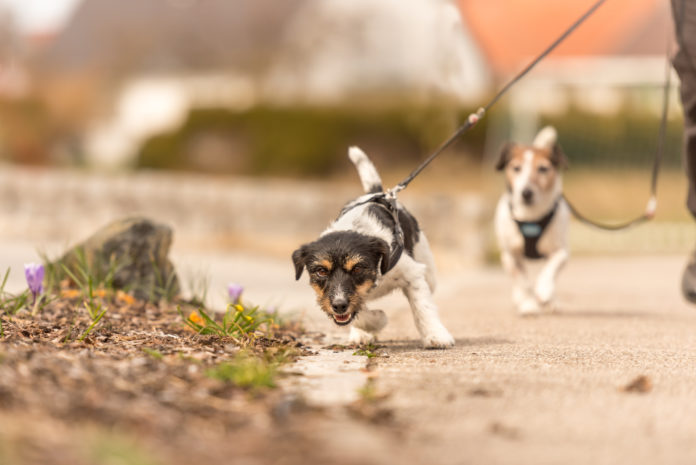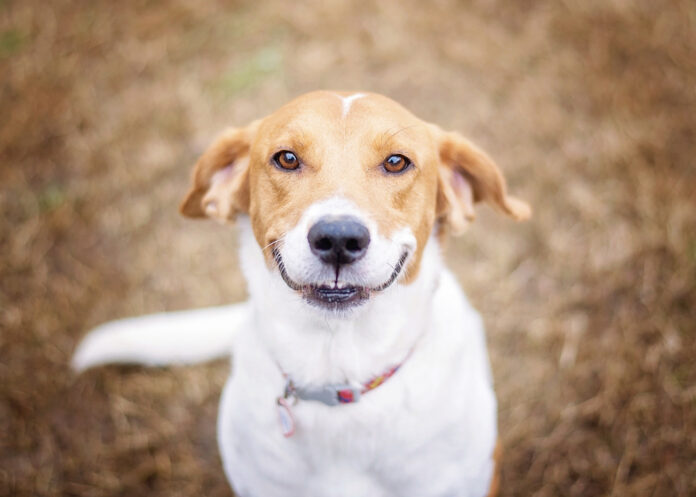Does your dog lunge and bark on walks?

They’re common problems, but they can make walking your dog less than enjoyable. The key to stop him from barking and lunging on the leash is to identify his triggers and re-train him not to react to them.
Do you cringe at the thought of walking your dog because he’s less than a gentleman on the leash? Does he pull, lunge or bark at every little thing that enters his line of vision? When you’re home from your “walk”, does it feel as if your arm is about to fall out of its socket? If you answered “yes”, you’re not alone. The good news is that you can transform these behaviors so you can enjoy walking your best friend again.
 6 steps to set your dog up for success
6 steps to set your dog up for success
Teaching your dog to be calm and collected on a walk takes a big commitment. But it’s a commitment that is most definitely worth the effort. Walking and exploring the neighborhood, nearby parks and other destinations is so important for your dog’s physical and mental health.
1. Buy the right walking gear for your dog
A good front-clipping dog harness and 6′ leash is in order. By utilizing a harness that clips to the front, you will be able to help turn your dog toward you to redirect his actions. Otherwise, he’ll be standing on his back legs with his front legs up in the air, like a rearing horse, whenever he overreacts to something he sees.
2. Provide healthy treats and small motivational dog toys
This is a must if you want to be able to attract your dog’s attention away from his target. The treats and toys must be something your dog finds extremely motivating and engaging, and not just the same old snacks he gets for doing a sit in your living room.
3. List his triggers
Triggers are anything that causes him to become overstimulated and start barking, lunging or doing something else that makes it difficult for you to get his attention. Be specific. Don’t just list “dogs” as a trigger. Break it down. Maybe he’s fine if he see a dog 20’ away, but goes crazy if the dog is only 10′ away. Distance is a key element in determining your training strategy. When you are starting a training routine, you want to truly know what situations won’t cause your dog to explode, because that’s where you are going to start in your training program in order to achieve success.
4. Exercise him before your walk
Yes, before. Walking a dog is not very physical for him, unless he’s pulling you around like a maniac. If you want to increase your chances of a little more calmness at the end of the leash, a nice play session or ball toss is a great way to burn off some excess energy before heading out the door.
 5. Choose the right location and time of day for training
5. Choose the right location and time of day for training
Remember to think about your dog’s specific triggers, and the distance he needs to be away from them in order not to react. This is what you will need to work with during your excursions. It may involve going to a quiet park instead of walking your dog out the front door. It’s incredibly important to know his limits, and to stay within those limits, or you won’t succeed.
6. Walk only one dog at a time
If you normally walk more than one dog simultaneously, you will have to walk only one at a time during this process. This is important when training your dog to stop barking, pulling and lunging on the leash. When a dog is un-learning a behavior, it’s impossible to be successful with two dogs in tow. If this means you are taking each dog on shorter walks, that’s okay. It’s actually a great way to train and to connect to each dog individually. Once you get the behaviors you want nailed down, then you can think about merging them again.
The training protocol
Now that you have aligned all your tools, it’s time to get started. Keep in mind that this is not going to be a race to the finish line, but rather slow steady progress with setbacks. Knowing this when you start out will hopefully prepare you for what’s involved.
Decide on how long your training sessions will be. You can do this either by deciding how many treats you will provide, or how much time you will spend on the lesson. Don’t choose a destination as a goal because, in the beginning, it’s going to go slow.
Start walking your dog and reward him for good behavior. It doesn’t matter if a trigger isn’t present; you just want to start him in on the game of paying attention to you. Incorporate his existing training cues, such as sit, watch, or any other behaviors he knows.
You need to see his triggers before he does
It’s critical to your dog’s success that you see his triggers before he does, so you really need to be aware of your surroundings. Let’s say you know he reacts to a dog 10′ away. You see that dog coming down the street 100′ away. You’ll want to make sure that when your paths cross, you stay away from the 10’ mark by keeping your dog 15′ or more away, even if it means you have to turn around and head in the other direction. This is why a specific destination isn’t a goal in this type of training. Once your dog sees the other dog, say “yes”, immediately feed him five to ten treats, and tell him how smart he is. You can then continue on and reward your dog for just looking, or turn in the other direction and wait for the next trigger to appear.
You want to continue this process for all your dog’s triggers. When he gets to the point where he looks up at you when he sees a trigger, as if to say, “Hey, where’s my treat?”, you know you are on the right path. That’s when you can look at getting closer to that particular trigger. So instead of staying 15′ away from the other dog, maybe next time it’s 10′, then 8′, 6′ and so on. How quickly you can get closer will depend on your dog’s previous behavior and how often you are taking him out and practicing.
During the training process, it’s important to keep evaluating your dog’s emotions and behavior. If it seems he’s starting to get too worked up, take a step back, add distance from the trigger, and play some games. If a lot of triggers are happening at once, your dog will go into overload. Try to prevent this from happening by staying in his comfort zone, doing short sessions, and taking breaks.
Keep in mind that you don’t have to do this alone. If you feel you need a little coaching or guidance, hire a positive dog trainer to help you navigate through this journey. With a good training plan, motivation and patience, you and your dog can tackle his leash madness!




